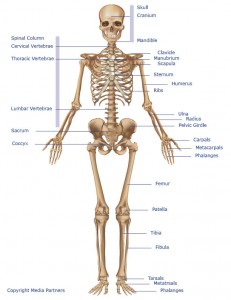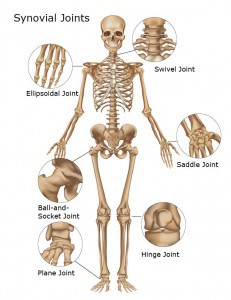The anatomy of our musculoskeletal system is quite complex. It consists of a large number of tendons, ligaments, bones, cartilage, joints, and bursae. We are able to control our muscles by sending stimulating impulses via nerves from our brain. The muscles are attached to the bones via rope-like structures called tendons. Our skeletal system is made up of over 200 individual bones. Ligaments are strong ligamentous structures that typically anchor bones to one another. Bursae are small fluid-filled sacs that typically exist at high friction points near joints. They act to protect ligaments and tendons from rubbing against bare bones.
The Skeleton

Our skeleton consists of a strong and solid internal framework of bones within our body. The bones of the skeleton give our body its shape, protect and support our organs, brain and spinal cord, and make it possible for us to move. Bones do not move on their own; muscles move our bones by pulling on them. Muscles cannot push against the bone, so muscles typically come in pairs (known as antagonists), one muscle pulls the bone one way and the antagonistic muscle pulls the bone back the other way.
Structurally, bones are somewhat elastic because they are primarily made up of collagen. Hydroxyapatatite, which consists mainly of calcium and phosphate, gives bone its hardness.
Most bones (particularly the long bones of the arms and legs — which make up the appendicular skeleton) have a hard outer shell known as cortical bone. At the microscopic level, this hard outer shell is made up of rod like structures called osteons. Within the hard outer shell, exists an area made up of spongy bone, known as cancellous bone. Finally, many bones have an inner core that houses a jelly like substance called marrow.
Bones have special cells called osteoblasts that make new bone and osteoclasts that break up the old bone. These cells are constantly working to keep your bones healthy and strong. Our bones are constantly being rebuilt (or remodeled) on a day to day basis to maintain optimal function.
Many bones come in pairs that are almost identical in size and shape — i.e. the bones in the left arm are mirror images of the bones in the right arm. Our bones can be joined together by rubbery cartilage or flexibly linked by muscles or ligaments.
A baby’s skeleton typically consists of more individual bones. As the baby grows, some of the bones fuse, such as the bones in the skull, spine, and the pelvis. Prior to adulthood, bones grow by getting longer and wider at the growth plate (or physis).
Females tend to have smaller bones than males of the same age.
Clinically, various diseases of the bone, including osteoporosis (i.e. weakening of the bones) can affect any one of the bones. Furthermore, with trauma (e.g. fall, motor vehicle accident), any of these bones can be broken (or fractured). This may require treatment.
There are two main parts of the skeleton—the axial skeleton and the appendicular skeleton:
The Axial Skeleton
Bones of the axial skeleton include:
- Skull (facial and cranial bones)
- Vertebrae in the spine (backbones)
- Ribs
- Sternum (breastbone)
Our shoulders, arms, pelvis, and legs (i.e. the appendicular skeleton) hang from the axial skeleton.
The Appendicular Skeleton
The appendicular skeleton is made up of our limbs: shoulders, arms, pelvis, legs.
Bones of the Upper Extremity
- Shoulder girdle—scapula (shoulder blade), clavicle (collar bone)
- Humerus—long bone of the upper arm
- Radius—long bone of the forearm; connects with the humerus to form the elbow
- Ulna—long bone of the forearm; connects with the humerus to form the elbow
- Carpals—8 small bones of the wrist
- Metacarpals—small bones of the hand
- Phalanges—14 bones of the fingers (3 in each finger) and thumb (2 in the thumb)
Bones of the Lower Extremity
- Pelvic Girdle—made up of the ilium, ischium, and pubic bone, which form a ring-shaped structure by connecting in the back via the sacrum and in the front at the symphysis pubis
- Femur—long bone of the thigh and longest bone in the body; connects with the pelvis to form the hip joint. Connects with the tibia and fibula to form the knee joint
- Tibia—long bone of the lower leg (shin bone); connects with the femur to form the knee joint
- Fibula—Thinner, long bone of the lower leg
- Patella—kneecap (see knee anatomy)
- Tarsals—small bones of the hindfoot
- Metatarsals— form the forefoot
- Phalanges—bones of the toes (3 in each toe and 2 in the big toe)
Joints of the Body
Joints are formed where the surfaces of two or more bones meet and articulate with one other. Some joints do not allow for any motion or at most, very little motion. Freely movable (diarthrodial) joints allow for motion that enables us to eat (elbow, hand), run (hip, knee, ankle), throw (shoulder, elbow), etc. Diarthrodial joints are classified by the type of movement they allow (See below). Depending on the type of joint, variable types of motion are possible.
There are many types of tissues that make up joint anatomy. Typically, the bones that make up freely mobile joints are lined with articular (or hyaline) cartilage. Hyaline cartilage has a very smooth, almost frictionless surface, which allows for smooth, pain-free motion at the joint.
Joints can be classified according to their degree of mobility:
Types of Functional Joints
- Immovable (synarthrosis) —bones are held together by firm fibrous tissue so they are essentially motionless; examples include the bones of the skull.
- Slightly movable (amphiarthrosis) —the bones are held together by various types of cartilage that allow for some movement; examples are the spinal segments or the symphysis pubis
- Freely movable (diarthrosis) — what most people classically refer to as “joints”. Also referred to as synovial joints, these joints allow for the most motion; examples include the shoulder, hip, and knee joints.
Synovial Joints
Perhaps the most functionally significant joints of the body are our freely movable joints, otherwise known as synovial joints. These synovial joints are found all over our body.
The ends of the bones that make-up synovial joints are covered with articular (or hyaline) cartilage. Hyaline cartilage functions as a protective cushion to the underlying bone and a slick surface that enables pain-free and smooth motion at the joint.
Synovial joints are typically surrounded by a tough, fibrous, capsule of connective tissue that connects the bones to one another granting some stability to the joint. Additionally, many of these joints may further be reinforced by additional ligamentous structures e.g. collateral ligaments of the knee.
The joint capsule is lined with a soft tissue structure called the synovial membrane. The synovial membrane (or synovium) consists of cells that produce a slick, lubricating fluid called synovial fluid. Synovial fluid further increases the slickness of the joint surfaces, allowing for very smooth and pain-free motion at the joint.
Finally, there are many muscles that typically cross joints that also help to stabilize the joints. More importantly, they allow for motion across the joints.
Types of Synovial Joints

There are many types of synovial joints. They are categorized based on both the type of movement that the joint allows as well their structure:
- Gliding joints: Consist of flat or slightly curved articular surfaces that allow for gliding movements in very specific directions. Examples of a gliding joint are the intertarsal and intercarpal joints of the feet and hands, respectively.
- Hinge joints: Have a convex (curved outward) part of bone that fits into a concave (curved inward) part of another bone. The action of the hinge joint is like that of a door hinge and motion is limited to bending and straightening. Our elbow and knee joints are examples of hinge joints.
- Pivot joints: Have a bone with a rounded end fitting into a groove in another bone. Pivot joints allow one bone to pivot around the other bone. An examples of this is the radio-ulnar articulation which allows for pronation (palm down) and supination (palm up) of the forearm.
- Saddle joints: The only saddle joints are in the thumb.
- Ball-and-socket joints: Bones of these joints fit together like a ball in a socket i.e. the round end of one bone fits into the concave socket of the other bone. The only ball-and-socket joints are in the shoulders and hips.
Joint Range of Motion
Range-of-motion refers to how much a joint moves and the direction in which it moves. All joints have a normal range of motion i.e. when healthy and normal they should be able to move a certain distance and direction(s). Range of motion is most accurately measured in degrees using a goniometer.
A joint may have a limited or decreased range of motion when it cannot move through its normal range of motion. Limited motion can be caused by injury, aging, a mechanical problem, or a disease process (such as osteoarthritis). Much less commonly, joint motion may even be increased. When your doctor examines your joints, he or she will determine if joint motion is normal, limited, or increased.
Joints of the Upper Appendage (Arm)
- Shoulder—It is the most freely mobile joint in the body. It allows the arm to come forward, out to the side, reach for the other arm, and reach behind you.
- Elbow—the elbow can bend from 0 – 160 °.
- Carpal—wrist joint
- Phalangeal—finger joints
Joints of the Lower Appendage (Leg)
- Hip— The hip joint is formed where the femur joins with the pelvis. The hip joint allows the leg to kick out in front of you, behind you, rotate inwards or outwards, come across your body, and move away from your body.
- Knee—the knee can bend from 0 – 140 °. The knee joint is formed by the tibia, fibula, femur and patella.
- Metatarsal—joints in the foot
- Phalangeal—joints in the toes
